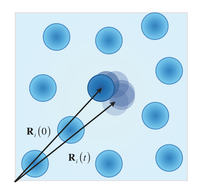Protein self-diffusion: ILL and ESRF provide essential biological insightNew biophysics data collected at ILL and ESRF will help biochemists make in vitro experiments more physiologically relevant by taking into account macromolecular ‘crowding’ inside cells. Researchers found that crowding has a significant effect on protein diffusion at the nanosecond timescale. This has implications for all biochemical processes and reaction rates when comparing lab results to cell physiology. A publication in PNAS Although BSA is a globular protein it is not an exact sphere; it actually has a complicated and floppy shape with a heterogenous surface charge. This is a problem for theoretical physics which can at present only model hard spheres with a homogenous surface charge. The researchers investigated whether the theory was a suitable basis for a model of macromolecular crowding by calculating the equivalent sphere size of a single BSA protein and comparing the theoretical and computer simulation predictions of its rate of movement with experimental data.
Further information Roosen-Runge F et al, Protein self-diffusion in crowded solutions, PNAS July 2011
|



